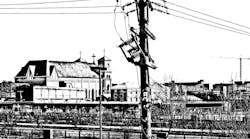On March 2, James Q. Wilson, the renowned social scientist who co-invented the “broken windows” theory, died at the age of 80.
Wilson championed the idea that eradicating signs of community decay is crucial to making neighborhoods healthier.
In a small coincidence, in the last installment in this column, we explored Wilson’s ideas relating to industrial productivity — concepts academically rigorous enough to pass muster under scientific scrutiny and application. Happily, the inspiration of James Q. Wilson survives wherever regional renewal occurs.
Of course, reawakening the glory of communities in the U.S. (and their manufacturing presence) goes beyond the physical. Essential to repurposing structures is the tidying of property records — a task increasingly falling to public authorities known as landbanks, which collect, manage, and then release foreclosed property for reuse.
“Local landbanks are typically passive, and cannot sustain the holding of commercial property, particularly when it has environmental issues, because of liabilities,” explains Gus Frangos, president of the Cuyahoga County Land Reutilization Corp., in Northeast Ohio.
In contrast, some newer independent nonprofits, including the Cuyahoga reutilization group, have governmental purpose and powers and are structured to actively support development. Though still limited in some ways, they wield unique authority to remove mortgage liens, clear title and taxes through tax foreclosure, and briefly hold property tax-free while new developers put their business plans together.
Residential properties tend to settle in landbanks by foreclosure through bank, HUD, and Fannie Mae relationships. In contrast, distressed or delinquent commercial properties usually come to landbanks by stakeholder donation, county development intervention, or even private involvement. “It’s more transactional, and that’s what the private sector does well, and what we need — something entrepreneurial and adaptive,” says Frangos.
From there, two things can happen: Individuals can approach the landbank with a specific plan for say, a fallow warehouse, and then make use of the landbank’s services, assured that they’ll actually acquire the land in question after securing financing and initiating physical cleanup. Alternatively, landbanks can execute searches for individuals seeking a certain type of property.
“We scour state forfeiture and tax-foreclosure lists by property size, type, and geography for commercial properties that can accommodate a particular application,” says Frangos, “though searches and subsequent title cleansing require an firm development agreement with a set timeframe from the prospective owner — so the landbank isn’t stuck with the property, or accused of flipping.” Despite the legal commitment required, there is strong demand for these services — and once properties are deeded to new owners, redevelopment attracts more private investment. The effect is magnified when adjacent locations are assembled for coordinated redevelopment.
In fact, not for the first time, the bounty of our land offers untold working space and opportunities to entrepreneurs with creative spirit. It’s a quintessentially American problem — one of inefficiently leveraged abundance — that a surplus of industrial space outstrips demand. No matter: As in the past, it is for innovators looking to stake their claim, drive productivity, and lead progress that these spaces await their ultimate purpose.
— Elisabeth Eitel • [email protected]
Article image of Dayton, Ohio courtesy David Wagner.

